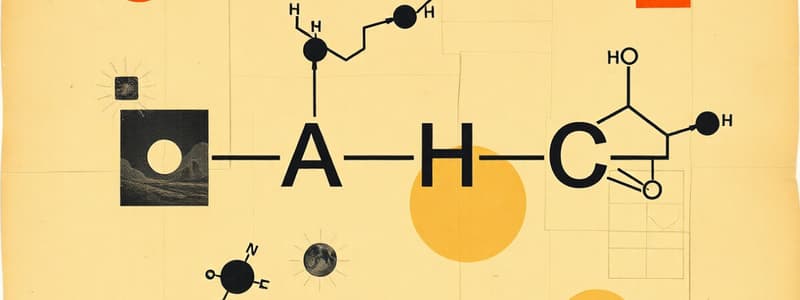Podcast
Questions and Answers
What are the two elements found in an alkene?
What are the two elements found in an alkene?
Carbon and hydrogen
What is the general formula for the ending of an alkene?
What is the general formula for the ending of an alkene?
-ene
Flashcards
Alkenes Definition
Alkenes Definition
Organic molecules containing a carbon-carbon double bond (C=C).
Alkenes Characteristics
Alkenes Characteristics
Alkenes are nonpolar and insoluble in water, featuring the -ene suffix.
Alkynes Definition
Alkynes Definition
Organic molecules containing a carbon-carbon triple bond (C≡C).
Alkynes Characteristics
Alkynes Characteristics
Signup and view all the flashcards
Alcohols Definition
Alcohols Definition
Signup and view all the flashcards
Alcohol Solubility
Alcohol Solubility
Signup and view all the flashcards
Primary Alcohol
Primary Alcohol
Signup and view all the flashcards
Secondary Alcohol
Secondary Alcohol
Signup and view all the flashcards
Tertiary Alcohol
Tertiary Alcohol
Signup and view all the flashcards
Thiols Definition
Thiols Definition
Signup and view all the flashcards
Thiols Characteristics
Thiols Characteristics
Signup and view all the flashcards
Ethers Definition
Ethers Definition
Signup and view all the flashcards
Ethers Characteristics
Ethers Characteristics
Signup and view all the flashcards
Aldehydes Definition
Aldehydes Definition
Signup and view all the flashcards
Aldehydes Solubility
Aldehydes Solubility
Signup and view all the flashcards
Ketones Definition
Ketones Definition
Signup and view all the flashcards
Ketones Solubility
Ketones Solubility
Signup and view all the flashcards
Carboxylic Acids Definition
Carboxylic Acids Definition
Signup and view all the flashcards
Carboxylic Acid Solubility
Carboxylic Acid Solubility
Signup and view all the flashcards
Esters Definition
Esters Definition
Signup and view all the flashcards
Esters Characteristics
Esters Characteristics
Signup and view all the flashcards
Amines Definition
Amines Definition
Signup and view all the flashcards
Amines Solubility
Amines Solubility
Signup and view all the flashcards
Amides Definition
Amides Definition
Signup and view all the flashcards
Study Notes
Functional Groups
- Functional groups are specific groups of atoms within molecules that are responsible for the characteristic chemical reactions of those molecules.
- Alkenes, alkynes, alcohols, thiols, ethers, aldehydes, ketones, carboxylic acids, esters, amines, and amides are examples of functional groups.
Alkenes
- Contain only carbon and hydrogen (C, H).
- Have a carbon-carbon double bond (C=C) in the molecule.
- Are nonpolar.
- Are not water-soluble.
- Use the suffix "-ene" in their names.
- The carbon chain needs to be numbered to indicate the position of the carbon-carbon double bond.
- Functional groups (FG's) take priority over branches when numbering the carbon chain.
Alkynes
- Contain only carbon and hydrogen (C, H).
- Contain a carbon-carbon triple bond (C≡C) in the molecule.
- Are nonpolar.
- Are not water-soluble.
- Use the suffix "-yne" in their names.
Alcohols
- Contain carbon, hydrogen, and oxygen (C, H, O).
- Contain a hydroxyl group (-OH) bonded to a carbon atom.
- Are not bases because they are not ionic hydroxides.
- Are polar.
- Alcohols with four or fewer carbons are water-soluble.
- Use the suffix "-anol" in their names.
Thiols
- Contain carbon, hydrogen, and sulfur (C, H, S).
- Contain a sulfhydryl group (-SH) bonded to a carbon atom.
- Are slightly polar.
- Are slightly soluble in water.
- Have a skunk-like odor.
Ethers
- Contain carbon, hydrogen, and oxygen (C, H, O).
- Contain an oxygen atom bonded to two carbon atoms.
- Are slightly polar.
- Are not water-soluble.
- Are named differently due to the breaking of the carbon chain by the oxygen atom.
- Each carbon chain connected to the oxygen is named as a branch (ending in -yl).
- Different-sized carbon chains are listed alphabetically.
- Use the term "ether" as a separate word in the name.
Aldehydes and Ketones
- Contain carbon, hydrogen, and oxygen (C, H, O).
- Aldehydes have a carbonyl group (C=O) at the end of a carbon chain.
- Ketones have a carbonyl group (C=O) on an interior carbon atom.
- Are polar.
- Aldehydes and ketones with four or fewer carbons are typically not water-soluble,
- Aldehydes use the suffix "-anal".
- Ketones use the suffix "-anone".
- Location of the functional group requires a number in names for ketones, but not for aldehydes.
Carboxylic Acids
- Contain carbon, hydrogen, and oxygen (C, H, O).
- Have a carboxyl group (-COOH) at the end of a carbon chain.
- Are polar.
- Carboxylic acids with four or fewer carbons are water-soluble.
- Use the suffix "-anoic acid" in their names.
- Have a noticeable, sometimes unpleasant, odor.
Esters
- Contain carbon, hydrogen, and oxygen (C, H, O).
- Are formed from the reaction of a carboxylic acid and an alcohol.
- Are slightly polar.
- Are not water-soluble.
- Are named using the alcohol component as a branch (-yl) and the carboxylic acid component as the main chain (-anoate).
Amines
- Contain carbon, hydrogen, and nitrogen (C, H, N).
- Have a nitrogen atom bonded to one or more carbon atoms.
- Are polar.
- Amines with four or fewer carbons are water-soluble.
- Use the suffix "-amine" in their names.
- Have a characteristic odor, often compared to decaying flesh.
Amides
- Contain carbon, hydrogen, nitrogen, and oxygen (C, H, N, O).
- Are formed from the reaction of a carboxylic acid and an amine.
- Are slightly polar.
- Are not water-soluble.
Studying That Suits You
Use AI to generate personalized quizzes and flashcards to suit your learning preferences.



